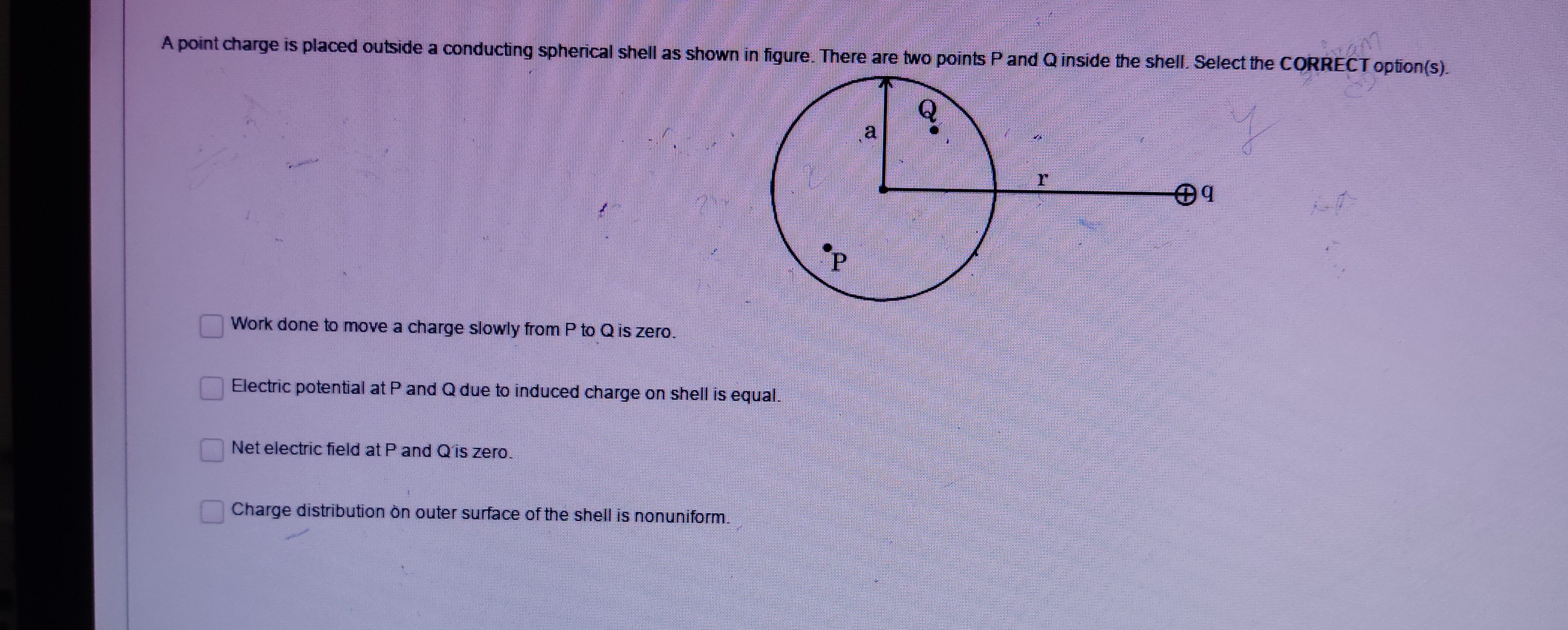Question
Question: A point charge is placed outside a conducting spherical shell as shown in figure. There are two poin...
A point charge is placed outside a conducting spherical shell as shown in figure. There are two points P and Q inside the shell. Select the CORRECT option(s).

Work done to move a charge slowly from P to Q is zero.
Electric potential at P and Q due to induced charge on shell is equal.
Net electric field at P and Q is zero.
Charge distribution on outer surface of the shell is nonuniform.
Work done to move a charge slowly from P to Q is zero., Net electric field at P and Q is zero., Charge distribution on outer surface of the shell is nonuniform.
Solution
The solution is based on the properties of conductors in electrostatic equilibrium.
-
Net electric field inside the cavity of a conducting shell is zero. This is a fundamental property of conductors in electrostatic equilibrium when there are no charges inside the cavity. The induced charges on the inner and outer surfaces of the shell arrange themselves in such a way as to cancel out the electric field due to the external charge at all points inside the cavity. Therefore, the net electric field at points P and Q is zero.
-
Electric potential is constant throughout the volume of a conductor and its cavity in electrostatic equilibrium. Since the net electric field inside the cavity is zero, the potential difference between any two points inside the cavity is zero. Hence, the electric potential is constant inside the cavity.
Let's analyze the given options:
-
Work done to move a charge slowly from P to Q is zero. The work done to move a charge q0 from P to Q is WPQ=q0(VP−VQ). Since P and Q are inside the cavity of the conductor, the electric potential at P and Q is equal, i.e., VP=VQ. Therefore, WPQ=q0(VP−VP)=0. This statement is correct.
-
Electric potential at P and Q due to induced charge on shell is equal. The total potential at any point is the sum of the potential due to the external charge and the potential due to the induced charges. Let Vtotal, Vext, and Vind be the total potential, potential due to the external charge, and potential due to the induced charges, respectively. So, Vtotal(r)=Vext(r)+Vind(r). Since P and Q are inside the cavity, Vtotal(P)=Vtotal(Q). However, the points P and Q are at different distances from the external charge, so Vext(P)=Vext(Q) in general. From Vext(P)+Vind(P)=Vext(Q)+Vind(Q), we have Vind(P)−Vind(Q)=Vext(Q)−Vext(P). Since Vext(Q)−Vext(P)=0 in general, it follows that Vind(P)=Vind(Q). This statement is incorrect.
-
Net electric field at P and Q is zero. As discussed above, the net electric field inside the cavity of a conducting shell in electrostatic equilibrium is zero. This statement is correct.
-
Charge distribution on outer surface of the shell is nonuniform. The external point charge is placed outside the conducting shell and is not at the center. This external charge induces charges on the shell. The induced charges on the outer surface will be distributed non-uniformly because the external charge is not symmetrically placed with respect to the center of the shell. The charge density will be higher on the side of the outer surface farther from the external positive charge. This statement is correct.
